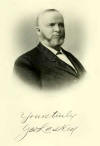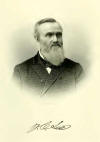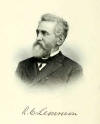OHIO GENEALOGY EXPRESS

A Part of Genealogy
Express
|
WELCOME to
LUCAS COUNTY, OHIO
History & Genealogy |

|
|
BIOGRAPHIES
 Source Source
HISTORY of CITY OF TOLEDO and LUCAS COUNTY, OHIO
Illustrated
Clark Waggoner, Editor
Publ. New York & Toledo:
Munsell & Company, Publishers
1888
< CLICK HERE to
RETURN to 1888 BIOGRAPHICAL INDEX >
< CLICK HERE to RETURN to LIST
of BIOGRAPHICAL INDEXES >

George Laskey |
GEORGE LASKEY
 Source: City of Toledo and Lucas County, Ohio -
Illustrated - Clark Waggoner, Editor - Publ. New York &
Toledo: Munsell & Company, Publishers 1888 - Page 692
Source: City of Toledo and Lucas County, Ohio -
Illustrated - Clark Waggoner, Editor - Publ. New York &
Toledo: Munsell & Company, Publishers 1888 - Page 692 |
 |
JOHN C. LEE, of
Toledo, was born Jan. 7, 1828, in Brown Township, Delaware County,
Ohio. His ancestors on both sides, were from the North of
Ireland. His parents, Hugh Lee, and Mary A. Lee, were
natives of Virginia, and came to Ohio soon after their marriage,
settling in Delaware County. The mother died in 1836, and the
family removed to the Town of Delaware in 1838, where they remained
until 1844, when they went to Union County, and in 1847 to Tiffin,
Seneca County, and thence, in 1851, to the West, where the father
pursued farming until his death in Missouri, in 1859, at the age of
61 years. The educational privileges of the son began in a
rude log School-house, and where limited to that until the removal
of the family to Delaware, where the way was opened for his
preparation for Central College, Franklin went to Western Reserve
College, at Hudson, in 1845 and was graduated in 1848. For two
years he taught Academies - one at Atwater, Portage County,
and one at Tiffin. Selecting the law for his profession, he
entered the office of R. G. Pennington, Esq., at Tiffin in
1850, and pursued his reading until July, 1852, when he was admitted
to the Bar, and became a partner of his tutor whom he soon succeeded
in his practice. Two years later, N. L. Brewer began
the reading of law with Mr. Lee and upon admission to the
Bar, became a partner. In 1857, Mr. Lee was a
Republican candidate for Judge of the Common Pleas Court, with
George E. Seney (Democrat) as the successful candidate.
Upon the outbreak of the Rebellion in April, 1861, Mr. Lee
surrendered his professional business to enter the military service
of the Government, enlisting in the Fifty-Fifth Ohio Volunteer
Infantry, of which he was at once made the Major, and was promoted
to its Colonelcy before reaching the field. In January, 1862,
he reported his command to General Rosecrans in West
Virginia. At Moorefield the Regiment first met the enemy, who
were defeated and the Town taken. After spending the month of
March as a member of a Court-martial, at Charlestown.
Colonel Lee rejoined the Regiment at Romney. By order of
General R. C. Schenck, he was given command of the District
of the South Potomac, and in May, 1862, under that officer,
marched for the relief of General Milroy, at McDowell; took
part in the Shenandoah campaign; and was in the battles of Freeman's
Ford, White Sulphur Springs, Warrenton, Bristow's Station, New
Baltimore, New Market, Thoroughfare Gap, Gainesville, Chantilly, the
Second Bull Run, and others, in which he bore parts which challenged
the approval of his superior officers. At Chancellorsville, in
1863, Colonel Lee commanded a Brigade, consisting of the
Twenty-Fifth, Fifty-Fifth, Seventy-Fifth and One Hundred and Seventh
Ohio Regiments, who did noble service there, while their commander's
prominence was indicated by his horse being shot under him. In
May, 1863, in consequence of the death of a child and the serious
illness of Mrs. Lee, the Colonel was forced to leave the
field, and his resignation was accepted May 18, 1863. During
the ensuing political campaign in Ohio, Colonel Lee took an
active part in support of John Brough, and against C. L.
Vallandigham, candidates for Governor of Ohio. The
condition of his family warranting his absence from home in the
Spring of 1864, he accepted the command of the One Hundred and
Sixty-Fourth Regiment Ohio Volunteer Infantry (National Guard),
which was assigned for service chiefly about the fortifications of
Washington City, where it remained, with more or less of activity,
until the aggressive movements of Grant about Richmond,
compelled the abandonment of the Rebel movement against the Capital.
During May, June and July of 1864, he was in command of all troops
from Long Bridge to Chain Bridge in the defenses of Washington.
His military service, throughout, was marked by a degree of
intelligence, earnestness, devotion and consideration for his
command, which from the first challenged the admiration and
confidence of superiors and subordinates. In good conduct and
discipline, his command evidenced the thoughtful care which alone
could have secured to them such distinction. The reports of
Second Bull Run made special mention of Colonel Lee's
efficiency in command. His regiment had been sent to an
advanced position, of special peril, and during the fight a Rebel
force made a flank movement, forming a line at right-angle with the
Union lines, making necessary a change of front by Colonel Lee,
whose command already was largely disorganized by being compelled to
fall back to the main line from the advanced position to which he
had been assigned. Regardless of Company organization, which
was lost, and under the raking fire of the enemy, he was able to
change front successfully by Battalion - instead of by Companies.
Such operation, under the circumstances stated, could be possible
only with men well disciplined and with full confidence in their
commander. Upon leaving the Army, General Lee resumed
the practice of the law at Tiffin. With this he was largely
identified with different interests of a public nature, serving for
five years as a member of the City Board of Education, and for seven
years as Chief Engineer of the Fire Department. In 1869 he
removed to Toledo, where he then formed a partnership with James
M. Brown, who had been a student under him at Tiffin. This
firm continued until 1882, when a son of the senior partner (Henry
E Lee), was admitted, the firm name becoming Lee, Brown & Lee.
This arrangement continued until the retirement of the Junior
partner in 1887. For a few years after becoming a voter,
Mr. Lee acted with the Whigs, but from its organization he was
co-operated with the Republican party, both as a voter and in such
more general methods as occasions have opened to him. Upon the
declination by Samuel Galloway, in 1867, of a nomination as
the Republican candidate for Lieutenant-Governor, General Lee
was selected for that position, and was elected being again
nominated and elected to the same place in 1869, serving for both
terms with Governor R. B. Hayes. As presiding officer
of the State Senate, he commanded the respect and confidence of that
body, irrespective of political divisions. On the occasions of
three State Republican Conventions, he was called to preside over
the same. In 1868 he was a delegate-at-large from Ohio to the
Republican National Convention; was a Presidential Elector-at-large
for Ohio, and President of the State Electoral College in 1872.
He was appointed United States Attorney for the Northern District of
Ohio, in 1877, his term expiring in March, 1881. His special
qualities both as debater and orator, early made him a favorite with
public assemblages, of all kinds, his power in political discussions
being exceptionally great. The appreciation of his talents and
character is best seen in the extent to which his services have been
called in public ways. Though without Church connection, he
has for many years been identified with Presbyterian and
Congregational Churches; and while an earnest advocate of
Temperance, he has not acted with a political Temperance party.
May 26, 1853, General Lee was married at Tiffin, with Miss
Charlotte E. Hoffman, a native of Germany. There were born
to them three children - a daughter (now dead), and two sons,
Frank A. and Henry E. Lee, both now residents of Toledo.
 Source: City of Toledo and Lucas County, Ohio -
Illustrated - Clark Waggoner, Editor - Publ. New York &
Toledo: Munsell & Company, Publishers 1888 - Page 53
Source: City of Toledo and Lucas County, Ohio -
Illustrated - Clark Waggoner, Editor - Publ. New York &
Toledo: Munsell & Company, Publishers 1888 - Page 53 |

R. C. Lemmon |
REUBEN C. LEMMON
 Source: City of Toledo and Lucas County, Ohio -
Illustrated - Clark Waggoner, Editor - Publ. New York &
Toledo: Munsell & Company, Publishers 1888 - Page 531
Source: City of Toledo and Lucas County, Ohio -
Illustrated - Clark Waggoner, Editor - Publ. New York &
Toledo: Munsell & Company, Publishers 1888 - Page 531 |

C. L. Luce |
CHARLES LEVERETT LUCE
 Source:
Story of City of Toledo and Lucas County, Ohio, Illustrated - Clark
Waggoner, Editor - Publ. New York & Toledo: Munsell & Company,
Publishers - 1888 - Page 764 Source:
Story of City of Toledo and Lucas County, Ohio, Illustrated - Clark
Waggoner, Editor - Publ. New York & Toledo: Munsell & Company,
Publishers - 1888 - Page 764 |
|
|
SAMUEL S. LUNGREN, M. D.
 Source: Story of City of Toledo and Lucas County, Ohio -
Illustrated - Clark Waggoner, Editor - Publ. New York &
Toledo: Munsell & Company, Publishers 1888 - Page 557
Source: Story of City of Toledo and Lucas County, Ohio -
Illustrated - Clark Waggoner, Editor - Publ. New York &
Toledo: Munsell & Company, Publishers 1888 - Page 557 |
|

CLICK HERE to RETURN to
LUCAS COUNTY, OHIO |
CLICK HERE to RETURN to
OHIO GENEALOGY EXPRESS |
FREE GENEALOGY RESEARCH is My MISSION
GENEALOGY EXPRESS
This Webpage has been created by Sharon Wick exclusively for Genealogy Express
©2008
Submitters retain all copyrights |
. |